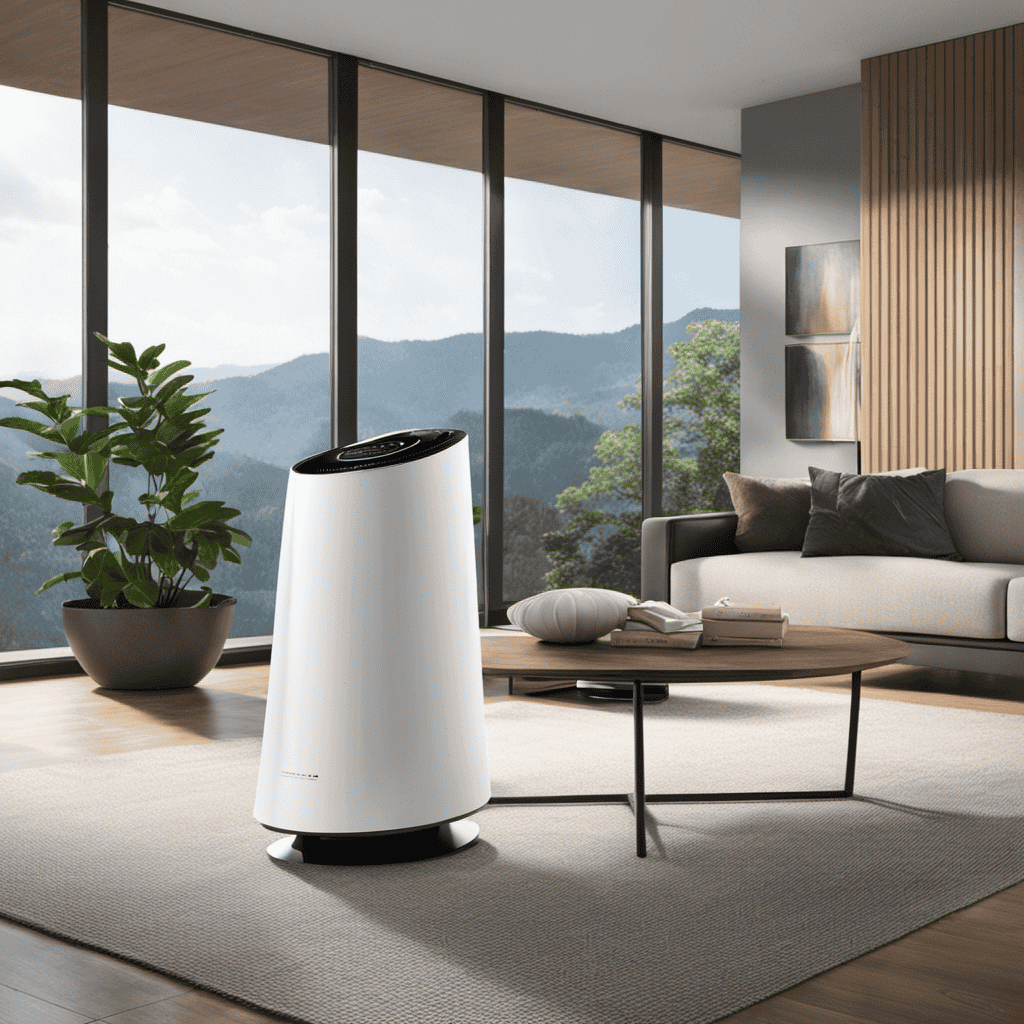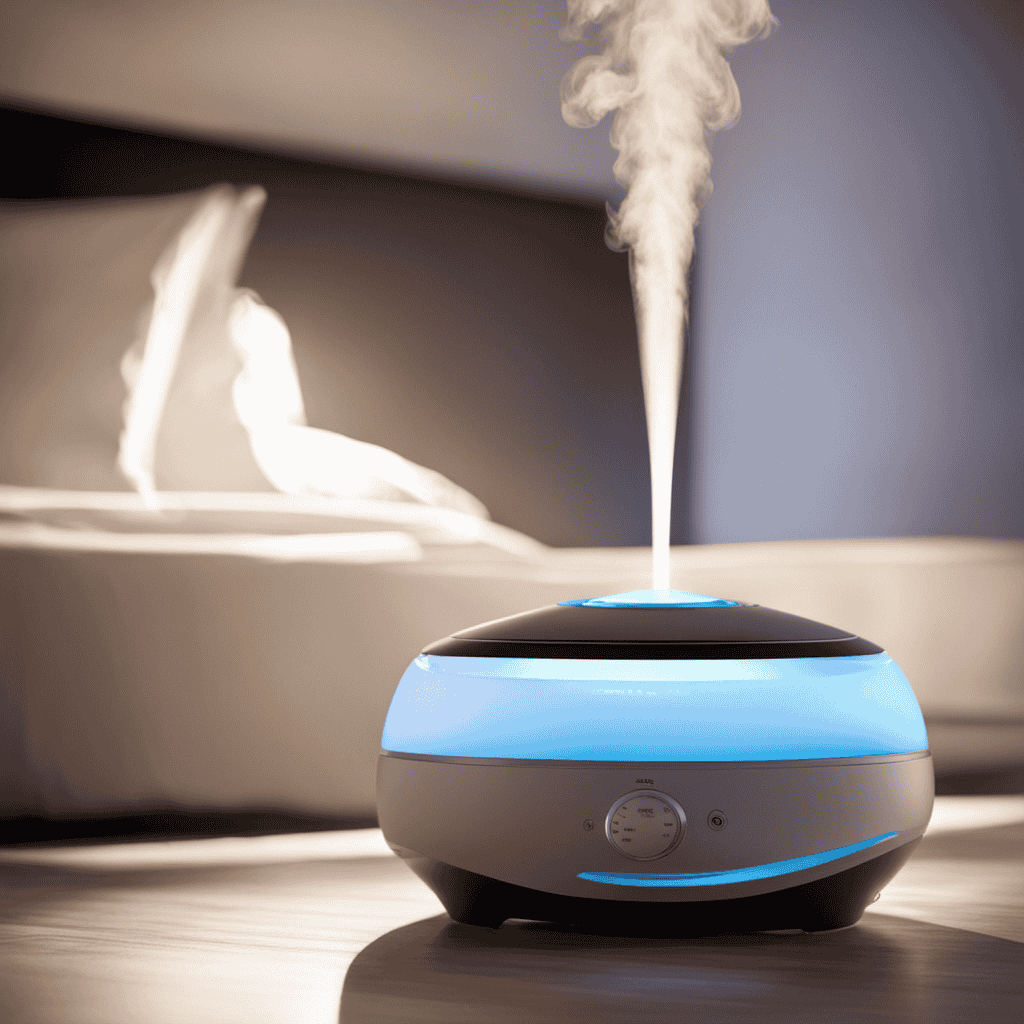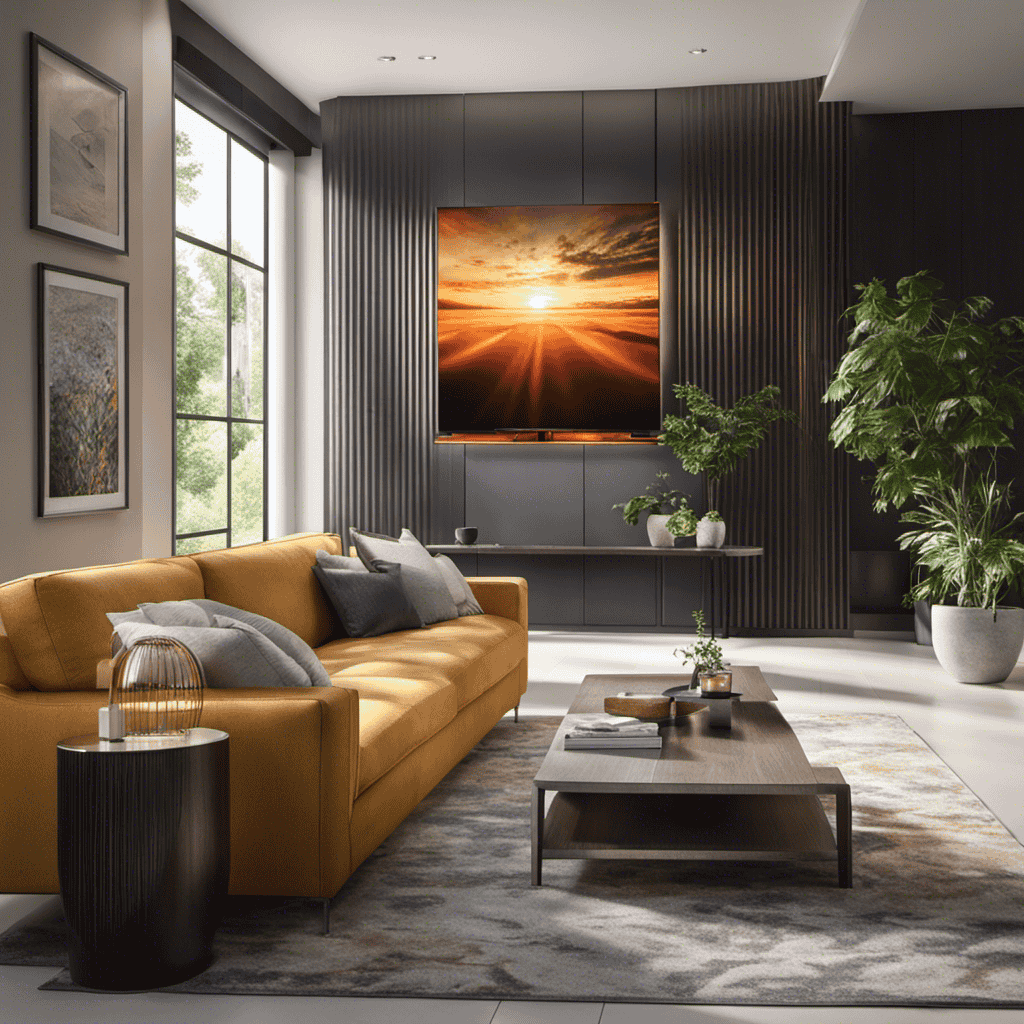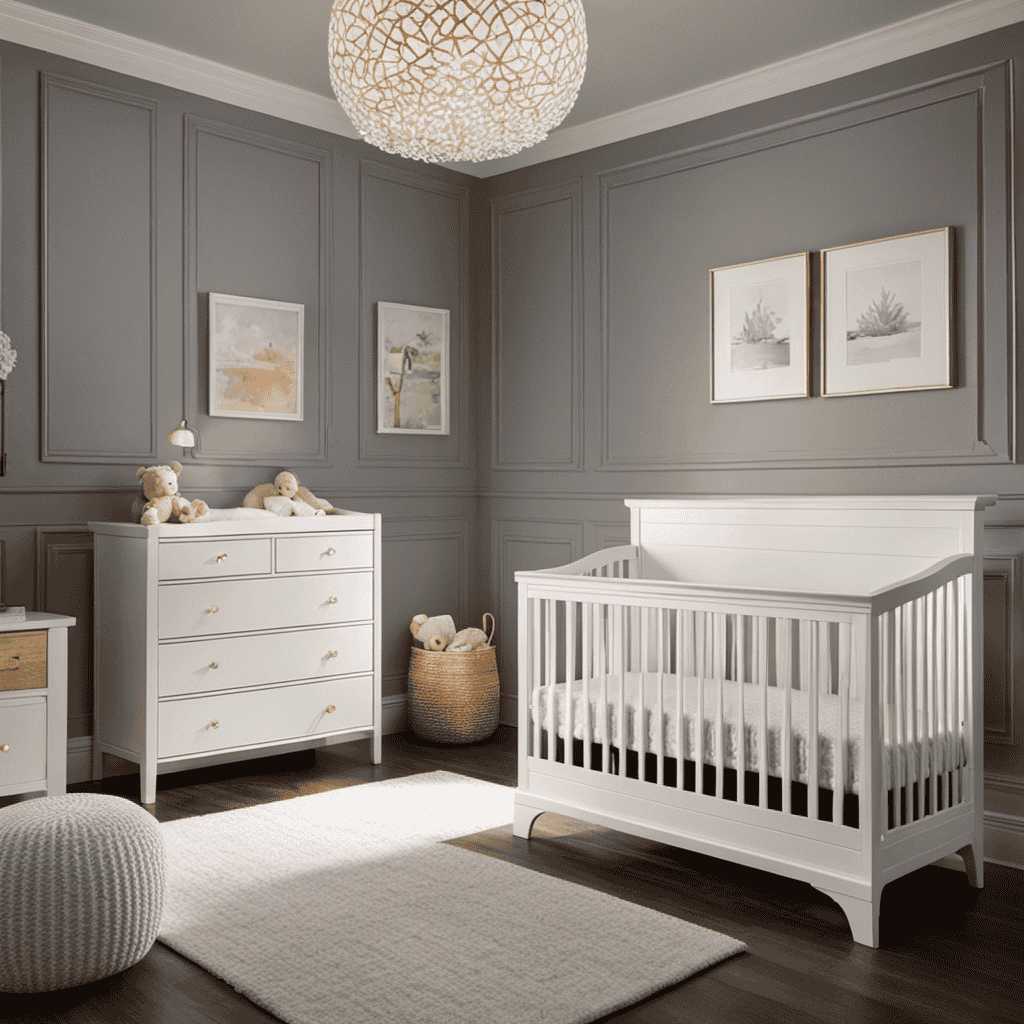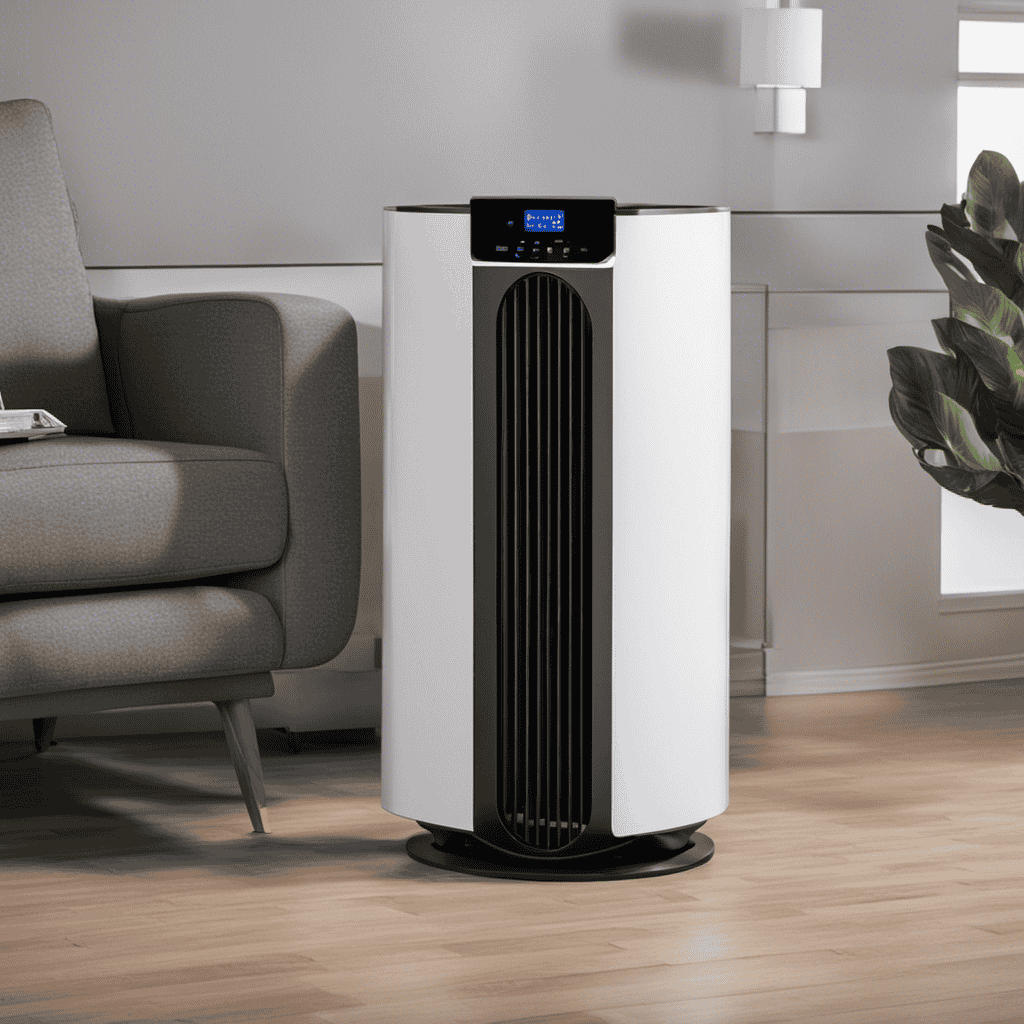As someone knowledgeable in indoor air quality, I can attest to the importance of finding the top air purifier for ensuring a clean and healthy environment.
Did you know that the average person spends 90% of their time indoors, where air pollution can be two to five times higher than outdoor levels?
With so many air purifier options available, it can be overwhelming to know which one is the best.
In this article, I will provide you with evidence-based information and scientific insights to help you make an informed decision.
Key Takeaways
- Indoor air pollution can be significantly higher than outdoor pollution, making air purifiers essential for maintaining a clean and healthy environment.
- HEPA filters are highly efficient in trapping small particles and allergens, improving indoor air quality and reducing the risk of respiratory problems.
- Activated carbon filters can effectively remove VOCs, harmful gases, and odors, contributing to improved indoor air quality.
- UV-C technology can effectively inactivate viruses and bacteria but should be used with caution due to potential harm to human skin and eyes.
HEPA Filters: What You Need to Know
HEPA filters are essential for trapping small particles and allergens in the air. Despite their importance, there are common misconceptions surrounding HEPA filters.
One such misconception is that they are only effective in trapping large particles. However, numerous studies have shown that HEPA filters are highly efficient in capturing particles as small as 0.3 microns.
Another misconception is that HEPA filters remove odors from the air. While they can help to reduce odor-causing particles, their primary function is to remove airborne contaminants.
The benefits of HEPA filters in air purification are undeniable. They can effectively remove dust, pollen, pet dander, and other allergens, improving indoor air quality and reducing the risk of respiratory problems.
With these benefits in mind, it is important to compare different air purifier brands to find the one that best suits your needs.
Comparing Different Air Purifier Brands
When comparing different brands, you’ll find that some air purifiers are more effective than others. Two important factors to consider are the type of filters used and the additional technologies employed.
HEPA filters are highly effective at capturing small particles such as dust, pollen, and pet dander. They can remove up to 99.97% of particles as small as 0.3 microns.
On the other hand, activated carbon filters are great at adsorbing odors, chemicals, and volatile organic compounds (VOCs).
UV-C technology, which uses ultraviolet light to kill bacteria and viruses, can be an effective addition to an air purifier.
Ionizers, on the other hand, release negatively charged ions that attach to airborne particles, causing them to settle on surfaces. It is important to note that some ionizers may produce small amounts of ozone, which can be harmful in high concentrations.
When choosing an air purifier, it is crucial to consider the specific needs and requirements of your environment.
Understanding CADR Ratings for Air Purifiers
When it comes to air purifiers, understanding CADR ratings is essential.
CADR, or Clean Air Delivery Rate, measures the effectiveness of an air purifier in removing airborne pollutants.
In this discussion, I will explain CADR simply, highlight the importance of high CADR, and discuss the factors that can affect CADR ratings.
CADR Explained Simply
The CADR rating tells you how well an air purifier can clean the air in a specific size room. It is an important factor to consider when choosing an air purifier because it indicates the effectiveness of the device in removing pollutants from the air.
There are several benefits of using CADR ratings to determine the best air purifier for your needs:
- Accuracy: CADR ratings are based on scientific testing methods, providing a reliable measure of an air purifier’s performance.
- Comparison: CADR ratings allow you to compare different air purifiers and choose the one that suits your room size and air quality requirements.
- Confidence: With CADR ratings, you can have confidence that the air purifier you choose will effectively clean the air in your room.
However, it is important to note the limitations of CADR ratings:
- Limited Scope: CADR ratings only measure the effectiveness of air purifiers in removing three specific types of pollutants: smoke, pollen, and dust. They do not account for other pollutants like mold, bacteria, or volatile organic compounds (VOCs).
- Room Size: CADR ratings are based on specific room sizes, so it’s crucial to choose an air purifier with a CADR rating appropriate for your room size.
Importance of High CADR
Having a high CADR is important because it indicates how efficiently an air purifier can clean the air in a specific room size. A high CADR means that the air purifier is capable of removing a larger volume of airborne particles, such as dust, pollen, and smoke, in a shorter period of time.
This is beneficial for maintaining good indoor air quality, especially for individuals with allergies or respiratory conditions. Studies have shown that improved indoor air quality can lead to a reduction in symptoms such as sneezing, coughing, and wheezing.
Additionally, a high CADR can help remove unpleasant odors and harmful gases from the air, creating a fresher and healthier living environment. Therefore, when considering an air purifier, it is important to choose one with a high CADR to ensure effective and efficient air cleaning.
Factors Affecting CADR
To ensure efficient air cleaning, you should consider factors that affect CADR, such as room size and the type of airborne particles present.
The following factors can influence CADR:
-
Room size: The size of the room plays a crucial role in determining the effectiveness of an air purifier. A larger room requires a higher CADR to effectively clean the air and remove pollutants.
-
Airborne particles: Different types of airborne particles have varying sizes and properties. Fine particles like dust, pollen, and pet dander can be effectively removed by air purifiers with higher CADR ratings, while larger particles like smoke and odors may require additional features like activated carbon filters.
-
Ventilation: The ventilation of the room also impacts CADR. Proper airflow helps distribute clean air throughout the room, enhancing the purification process.
Considering these factors will help you choose an air purifier with the appropriate CADR for your specific needs. Now let’s explore the benefits of activated carbon filters in the subsequent section.
The Benefits of Activated Carbon Filters
You’ll love the benefits of activated carbon filters in an air purifier.
Activated carbon is a highly porous form of carbon that is able to trap and remove various pollutants and odors from the air.
When used in air purifiers, activated carbon filters can effectively remove volatile organic compounds (VOCs), such as formaldehyde and benzene, as well as harmful gases like carbon monoxide and ammonia.
These filters work through a process called adsorption, where the pollutants are attracted to the surface of the carbon and held there.
This technology is widely used in air purifiers due to its ability to improve indoor air quality and reduce the risk of respiratory issues caused by pollutants.
UV-C Technology and Its Role in Air Purification
When considering the effectiveness of UV-C technology in air purification, it’s important to examine the scientific evidence. Studies have shown that UV-C light can effectively inactivate various microorganisms, including viruses and bacteria, by damaging their DNA or RNA.
However, it’s crucial to also address the safety concerns associated with UV-C, such as potential harm to human skin and eyes if not used properly.
Effectiveness of UV-C
The UV-C light is known to be effective in killing germs and bacteria in the air. It has been widely used in air purifiers to improve indoor air quality.
Here are some pros and cons of UV-C technology and its effectiveness against different air pollutants:
-
Pros:
-
Kills germs and bacteria: UV-C light can effectively kill airborne germs and bacteria, reducing the risk of infections.
-
Chemical-free: UV-C technology does not require the use of chemicals, making it a safe and environmentally friendly option.
-
Continuous purification: Once installed, UV-C lights can continuously purify the air without the need for filter replacements.
-
Cons:
-
Limited range: UV-C light has a limited range and can only disinfect the air that passes through the purifier.
-
Ineffectiveness against larger particles: UV-C technology is not effective against larger particles such as dust and pollen.
-
Potential health risks: Prolonged exposure to UV-C light can be harmful to humans, causing skin and eye irritation.
Safety Concerns With UV-C
In my research on the effectiveness of UV-C in air purifiers, I stumbled upon some safety concerns that are worth addressing. While UV-C technology has proven to be highly effective in killing bacteria and viruses, there are potential health risks associated with its use. UV-C light is harmful to human skin and eyes, and prolonged exposure can lead to skin burns and eye damage. Therefore, it is crucial to take safety precautions when using air purifiers with UV-C technology. One way to ensure safety is by purchasing air purifiers with built-in safety features such as automatic shut-off when the device is not in use or when the UV-C light is exposed. Additionally, following the manufacturer’s instructions and guidelines for proper usage and maintenance can help minimize the potential health risks associated with UV-C technology.
To further illustrate the importance of safety precautions and potential health risks, here is a table that highlights some key points:
| Safety Precautions | Potential Health Risks |
|---|---|
| Use air purifiers with built-in safety features | Prolonged exposure can lead to skin burns and eye damage |
| Follow manufacturer’s instructions for proper usage | UV-C light is harmful to human skin and eyes |
| Regularly clean and maintain the air purifier | Improper usage can result in potential health risks |
| Keep children and pets away from UV-C light | Safety precautions must be taken to minimize health risks |
Evaluating Air Purifiers for Allergies and Asthma
Evaluate air purifiers for allergies and asthma by considering their HEPA filter efficiency and CADR ratings.
When evaluating air purifiers for dust and pollen, it is important to prioritize those with high efficiency particulate air (HEPA) filters. HEPA filters are designed to capture particles as small as 0.3 microns, ensuring effective removal of allergens from the air.
Additionally, look for air purifiers with high Clean Air Delivery Rate (CADR) ratings. CADR measures the volume of clean air an air purifier can deliver per minute, specifically for pollen and dust. The higher the CADR rating, the faster the air purifier can remove these allergens from the air.
Air Purifiers for Pet Owners: Tips and Recommendations
When choosing an air purifier for pet owners, it’s important to consider factors such as filter type, noise level, and room size. Pet friendly air purifiers are designed specifically to tackle the issue of reducing pet dander in the air. These purifiers often feature HEPA (High-Efficiency Particulate Air) filters, which are effective in trapping tiny particles like pet dander. HEPA filters have been proven to remove up to 99.97% of airborne allergens, including pet dander. Additionally, air purifiers with activated carbon filters can help eliminate odors caused by pets.
It’s crucial to select an air purifier that is suitable for the size of the room where your pets spend the most time. By considering these factors, you can create a clean and healthy environment for both you and your furry friends.
Now, let’s discuss the importance of noise level in air purifiers.
The Importance of Noise Level in Air Purifiers
When it comes to choosing an air purifier, there are several factors to consider. These include noise level and performance. The noise level of an air purifier can greatly impact its usability, especially in environments where silence is important. This is particularly true for places like bedrooms or offices. However, it is important to strike a balance between noise level and performance. Some air purifiers may sacrifice effectiveness for quieter operation.
Noise Vs. Performance
If you want a quiet air purifier that still provides excellent performance, you should consider models that are specifically designed to minimize noise. These models have advanced noise reduction technology that allows them to operate at low sound levels without compromising their ability to effectively clean the air.
When it comes to performance testing, these air purifiers have been proven to remove a wide range of pollutants, including dust, pollen, pet dander, and even volatile organic compounds (VOCs). They have high CADR (Clean Air Delivery Rate) ratings, indicating their efficiency in removing airborne particles.
Additionally, these air purifiers often come with multiple filtration stages, including HEPA filters, activated carbon filters, and pre-filters, ensuring thorough and effective purification.
Sleep-Friendly Air Purifiers
For a more restful night’s sleep, I highly recommend considering a sleep-friendly air purifier. These purifiers are designed to operate quietly while still effectively cleaning the air in your bedroom.
When it comes to selecting the best air purifier for sleep, there are a few key features you should look for.
Firstly, choose a purifier with a low noise level. Noise can disrupt your sleep and make it difficult to fall asleep or stay asleep throughout the night. Look for purifiers that operate at a noise level below 50 decibels for a peaceful sleep environment.
Additionally, make sure the purifier has a sleep mode or a timer function that allows you to set it to operate for a specific duration, ensuring it doesn’t disturb your sleep once the air is clean.
Energy Efficiency: Finding an Eco-Friendly Air Purifier
To find an eco-friendly air purifier, you should look for one that is energy-efficient and has a low carbon footprint. This means that it uses less energy to operate, resulting in energy savings and a reduced environmental impact.
When searching for an energy-efficient air purifier, consider the following:
-
Look for models with a high energy star rating. These models have been tested and certified to meet strict energy efficiency guidelines.
-
Check the power consumption of the air purifier. Look for models that have low wattage or power usage to ensure energy efficiency.
-
Consider the size of the room or space where the air purifier will be used. Choosing the right size can help optimize energy savings.
How to Choose the Right Size Air Purifier for Your Space
When it comes to choosing the right size air purifier for your space, there are several key considerations to keep in mind.
First, you need to take into account the size of the room that you want to purify. A larger room will require a more powerful air purifier to effectively clean the air.
Secondly, you should consider the air purifier’s coverage area. Different air purifiers have different coverage areas, so it’s important to choose one that matches the size of your room.
Lastly, the effective cleaning capacity of the air purifier is crucial. This refers to how well the air purifier can actually remove pollutants from the air. It’s important to choose an air purifier with a high effective cleaning capacity to ensure that you’re getting the cleanest air possible.
Room Size Considerations
Room size is an important factor to consider when choosing the best air purifier. The effectiveness of an air purifier depends on its ability to circulate and filter the air in a given space. Here are three key considerations regarding room size and air purifiers:
-
Square footage: Determine the square footage of the room where the air purifier will be used. This information will help you select an air purifier with the appropriate coverage area.
-
Air changes per hour (ACH): Consider the desired ACH rate for the room. A higher ACH rate means the air purifier can filter the entire volume of air more frequently, resulting in better air quality.
-
Room ventilation: Assess the level of room ventilation. If the room has poor ventilation, an air purifier with a higher Clean Air Delivery Rate (CADR) is recommended to compensate for the lack of fresh air.
Considering these factors will help you choose the best air purifier for your specific room size and ensure its effectiveness in improving indoor air quality.
Air Purifier Coverage
Determining the appropriate coverage area of an air purifier is crucial when considering its effectiveness in improving indoor air quality. To ensure optimal performance, it is important to choose an air purifier that matches the size of the room.
Air purifiers are rated based on the maximum square footage they can effectively purify. For example, a purifier with a coverage area of 300 square feet would be suitable for a small bedroom or office.
Regular maintenance is also essential for the efficient functioning of air purifiers. This includes cleaning or replacing filters as recommended by the manufacturer.
Additionally, air purifiers can provide significant benefits for children. They help remove airborne allergens, pollutants, and particles, which can reduce the risk of respiratory issues and allergies, promoting better health and well-being.
Effective Cleaning Capacity
To ensure optimal performance, it’s important to choose an air cleaner that effectively covers the desired area. When it comes to selecting an air purifier, room size recommendations play a crucial role.
It is essential to consider the square footage of the room you intend to purify. Different air purifiers have varying coverage capacities, so finding one that matches your room size will ensure maximum effectiveness.
Additionally, filter replacement frequency is another important factor to consider. Filters are designed to trap pollutants, but they can become clogged over time. It is recommended to replace the filters regularly according to the manufacturer’s instructions to maintain the air purifier’s efficiency.
Regular filter replacements will ensure that the air cleaner continues to effectively remove allergens and pollutants from the air, providing you with clean and fresh indoor air quality.
Smart Features: Are They Worth It
Smart features on air purifiers can be convenient, but are they really worth the extra cost?
When it comes to smart home integration, having an air purifier that can be controlled through your smartphone or connected to your smart home system can add an extra level of convenience. With a user-friendly interface, you can easily adjust settings, monitor air quality, and receive notifications about filter replacement.
However, it’s important to consider whether these features are truly necessary for your specific needs. While they may offer added convenience and control, they can also drive up the cost of the air purifier. Ultimately, it’s a personal decision based on your preferences and budget.
Now let’s delve into another important aspect: maintenance and filter replacement – what to consider.
Maintenance and Filter Replacement: What to Consider
When considering an air purifier, it’s important to factor in maintenance and filter replacement. These aspects are crucial to ensure the device operates efficiently and effectively.
Here are some maintenance tips to keep in mind:
-
Regularly clean the pre-filter: The pre-filter captures larger particles and should be cleaned or replaced regularly to prevent clogging.
-
Replace filters as recommended: Different purifiers have varying filter lifespans, so it’s essential to follow the manufacturer’s guidelines for replacement.
-
Keep an eye on filter indicators: Some purifiers have filter replacement indicators that notify you when it’s time to change the filter.
By adhering to these maintenance tips, you can ensure your air purifier continues to provide clean and fresh air.
Now, let’s explore the next section on air purifiers specifically designed for smoke and odor elimination.
Air Purifiers for Smoke and Odor Elimination
If you’re dealing with smoke and odor issues, you’ll want an air purifier specifically designed for eliminating them. When it comes to choosing the right air purifier for smoke and odor elimination, there are a few key factors to consider.
First, look for a purifier with a true HEPA filter, as these are designed to trap even the smallest particles, including smoke particles and odorous molecules. Additionally, activated carbon filters are effective at adsorbing odors and volatile organic compounds (VOCs).
For pet owners, it’s important to select a purifier with a pre-filter to capture pet dander and hair. Some purifiers also feature an ionizer, which can help neutralize odors.
Finally, consider the size of the room you need to purify and choose a purifier with an appropriate CADR (Clean Air Delivery Rate) for smoke and odors.
The Role of Ionizers in Air Purification
Ionizers are effective at neutralizing odors and can be an important feature to consider when choosing an air purifier. They work by releasing negatively charged ions into the air, which attach to positively charged particles like dust, pollen, and pet dander. This causes the particles to become heavy and fall to the ground, effectively removing them from the air.
However, it is important to note that ionizers are different from ozone generators. While ionizers produce negative ions, ozone generators produce ozone, which can be harmful to human health when present in high concentrations.
When it comes to indoor plants, ionizers can be beneficial as they help in removing pollutants and improving air quality, which in turn promotes plant growth.
Overall, ionizers are a safe and effective option for odor neutralization, as long as they are used properly and in moderation.
-
Ionizers release negatively charged ions that neutralize odors and remove particles from the air.
-
Ozone generators produce ozone, which can be harmful to human health.
-
Ionizers can improve air quality and promote plant growth for indoor plants.
Air Quality Monitoring: What You Should Know
In my previous subtopic, I discussed the role of ionizers in air purification. Now, let’s delve into another crucial aspect of maintaining clean air: air quality monitoring. Understanding the quality of the air we breathe is essential for our health and well-being. Air pollution effects can be detrimental, especially when it comes to indoor air pollutants.
To help you grasp the importance of air quality monitoring, I have created a table below that outlines some common indoor air pollutants, their sources, and potential health effects:
| Indoor Air Pollutant | Sources | Health Effects |
|---|---|---|
| Volatile Organic Compounds (VOCs) | Cleaning products, paints, adhesives | Eye, nose, and throat irritation, headaches, nausea |
| Particulate Matter (PM) | Dust, pollen, pet dander | Respiratory issues, allergies, asthma attacks |
| Carbon Monoxide (CO) | Gas stoves, fireplaces, furnaces | Headaches, dizziness, unconsciousness, death |
| Radon | Soil, building materials | Lung cancer |
Frequently Asked Questions
Can Air Purifiers Completely Eliminate Smoke and Odors From a Room?
Yes, air purifiers can effectively eliminate smoke and odors from a room. They capture and filter out particles and chemicals, improving indoor air quality. This has numerous benefits, including reducing respiratory issues and creating a more pleasant living environment.
How Do Ionizers Work in Air Purification?
How do ionizers work in air purification? Negative effects can include ozone emissions, which can irritate the lungs. However, ionizers can also offer benefits like capturing and neutralizing airborne particles, improving indoor air quality.
What Are the Key Factors to Consider When Choosing an Air Purifier for Monitoring Air Quality?
When choosing an air purifier to monitor air quality, factors to consider include the type of air purifier (such as HEPA or carbon), room size, noise level, maintenance requirements, and cost.
Are There Any Health Risks Associated With Using UV-C Technology in Air Purifiers?
There may be potential dangers associated with using UV-C technology in air purifiers. It’s important to consider the health risks and weigh them against the benefits before deciding on an air purifier.
What Are Some Tips for Maintaining and Replacing Filters in Air Purifiers to Ensure Optimal Performance?
Maintaining and replacing filters is crucial for optimal performance of air purifiers. Regularly cleaning and changing filters helps to remove pollutants effectively and maintain clean air quality in your home.
Conclusion
In conclusion, after thoroughly researching and evaluating various air purifiers, it is clear that there is no ‘best’ air purifier. Despite the claims made by different brands, it ultimately comes down to personal preferences and specific needs.
It’s ironic how a simple device aimed at improving air quality can leave us in a state of confusion. However, armed with knowledge about HEPA filters, CADR ratings, activated carbon filters, UV-C technology, maintenance, and more, you can make an informed decision that suits your unique situation.
Happy purifying!
